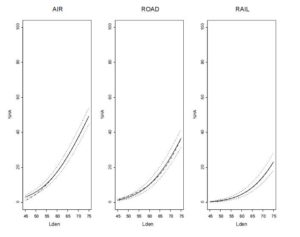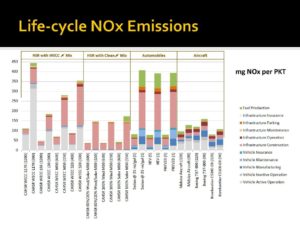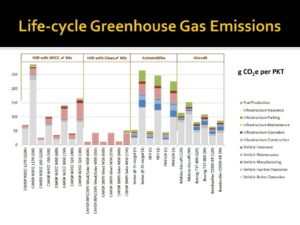Environmental Smackdown – Aviation v. High Speed Rail
02.14.2011 | HMMH |I’m inspired by a few recent events to pontificate on this subject; those events are: (1) Joe Biden’s recent remarks on high speed rail (HSR) in the US, (2) Greg Principato’s response, and (3) a recent session at the TRB Annual Meeting: “Environmental Tradeoffs of Aviation and High Speed Rail”.
First, let me be clear: I do not think that one mode of transportation is “better” than another. In fact, I’m quite sure that we have a need for both and our focus should be on complementarity, not competition. That said, high speed rail advocates in the U.S. are making statements that unequivocally claim that high speed rail is “better for the environment”. But let’s check the facts, as far as I’ve gathered them (admittedly, a somewhat cursory review):
- Capacity: Matt Coogan and others have prepared a comprehensive case study of the impact of high speed rail on aviation capacity in ACRP 31: Innovative Approaches to Addressing Aviation Capacity Issues in Coastal Mega-regions. They conclude that while introduction of Acela Amtrak service between Boston and New York has reduced passenger traffic by about 1/3, the number of flights between the two cities has dropped by only about six percent – shuttle operators have just adapted by substituting smaller aircraft on those routes to meet the schedule demand.
- Noise: Noise assessments for aviation and high speed rail both rely on Day Night Average Sound Level, but the similarities end there. The FRA’s HSR Guidance Manual determines impact on noise sensitive communities by comparing project levels to existing noise levels to determine two categories of impact (moderate and severe), while the FAA’s Order 1050.1E determines impact by identifying noise-sensitive land uses that are projected to experience an increase in noise of 1.5 dB or more in those areas already exceeding DNL 65. To make matters even more complicated, people appear to respond differently to aircraft noise than rail noise (they are more annoyed by it); on the other hand, if the rail vehicle in question is moving fast enough to cause startle (i.e., HSR), it’s not clear whether annoyance reaction is more like aircraft than rail. Ruth Mazer and I gave a presentation at TRB comparing aviation and HSR in the Boston-New York Acela corridor, using both the FRA methodology and the FAA’s Integrated Noise Model. We estimated that the number of people exposed to Sound Exposure Levels (SELs) from aircraft flying BOS-NYC high enough to cause speech disturbance (85 dB) ranges from 1,000 to 1,500 (depending on runway, flight path, aircraft type, and airport); whereas the number of people exposed to the same level on the BOS-NYC route is 12,000. On the other hand, there are close to 30 shuttle flights per day in each direction and only 10 trainsets. Is it better to expose the same 1,000 people to excessive noise 60 times per day or twelve times as many people only 20 times per day?

Source: EU Position Paper On Dose Response Relationships Between Transportation Noise And Annoyance, 2002: http://ec.europa.eu/environment/noise/pdf/noise_expert_network.pdf
- Air Quality: Mikhail Chester from UC Berkeley also gave a presentation at TRB entitled, “Life-Cycle Assessment of High Speed Rail: Total Environmental Accounting”, in which he compared the total air quality outputs from automobiles, aviation, and HSR. LCA includes not just the operation and maintenance of the vehicles, but the infrastructure development and energy production. Two interesting figures are presented below, which demonstrate that although emissions per passenger kilometer traveled (PKT) is highly dependent on vehicle loading, HSR consistently produces less CO2 than aviation only when it is assumed that the HSR uses “clean” fuel, and is not a clear “winner” over aviation when comparing NOx. More detail on Mikhail’s research is here.
I look forward to your responses, and to seeing some real data – especially noise – on this subject.







